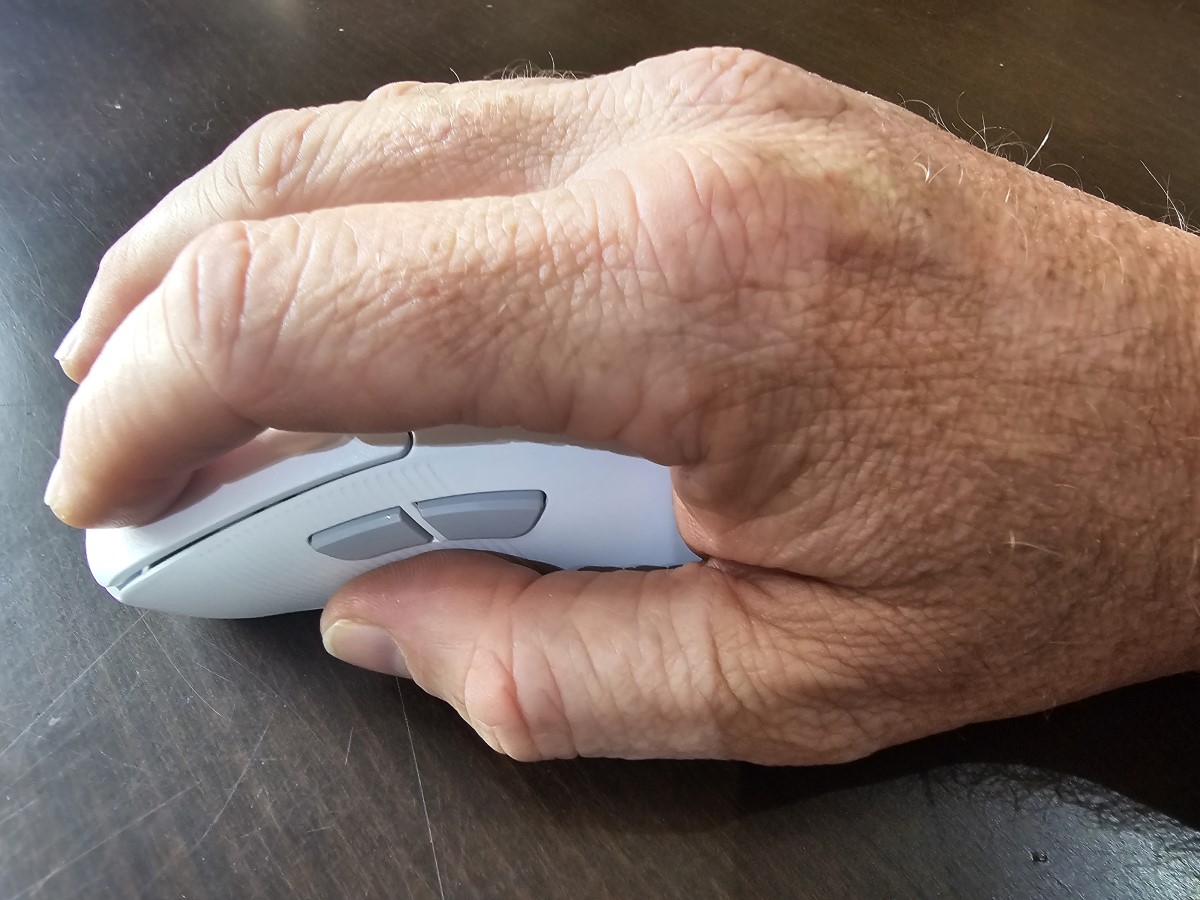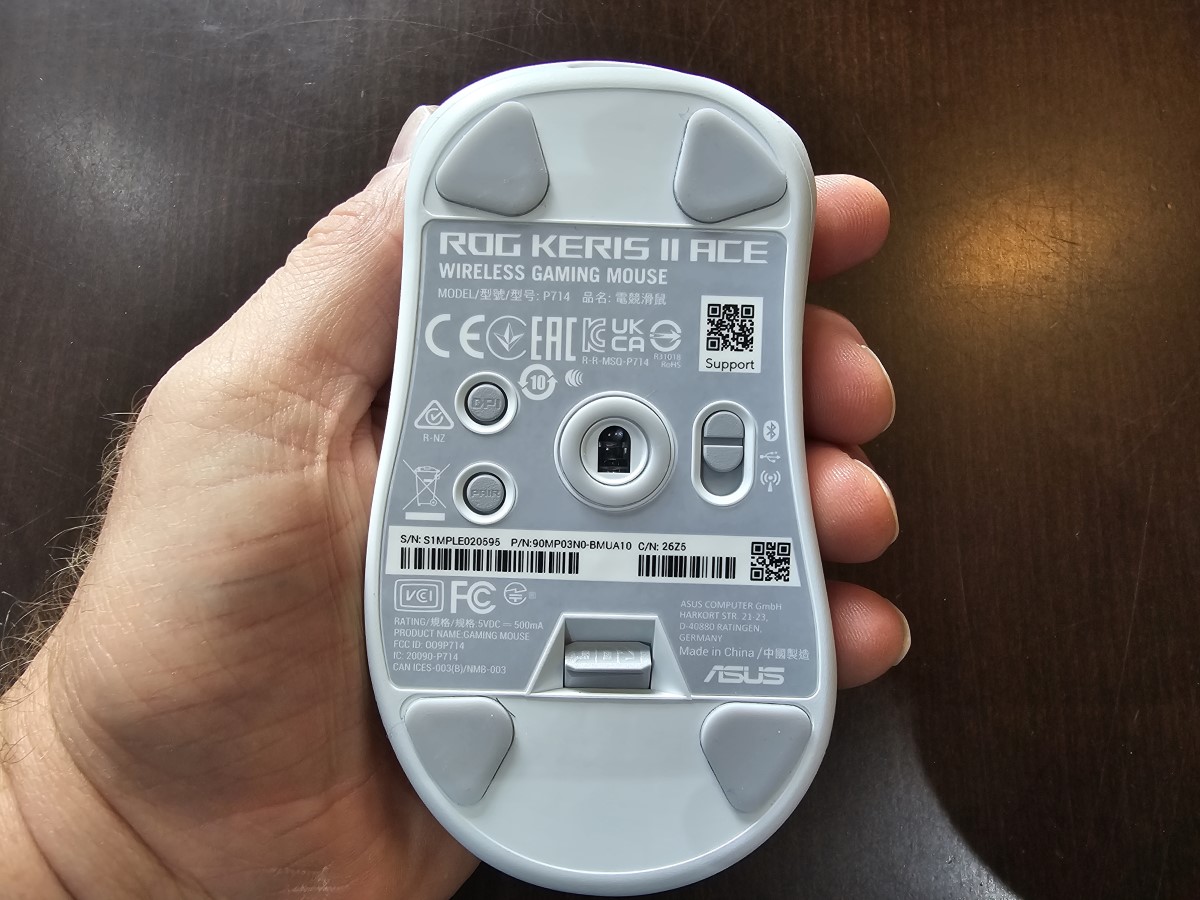Expert’s Rating
Pros
- Extremely powerful and sensitive sensor
- 4,000Hz polling rate with the booster adapter
- Has both Wi-Fi and Bluetooth connectivity
- Ultra-light design of just 1.9 ounces (54 grams)
Cons
- Only one RGB zone
- The dongle and 4,000Hz extension are very big
- The battery life isn’t as long as some esports mice
Our Verdict
The Asus ROG Keris II Ace boasts a combination of top-level features and functionality that you’d be hard pressed to find altogether in another FPS mouse. That makes it a dynamo — you’ll get some of the very best performance you’ve ever had in FPS games with this mouse.
Price When Reviewed
159
Best Prices Today: ROG Keris II Ace
$159.99

$475.12
For me the Asus ROG Keris II Ace sits at the top of ROG’s current wireless esports line-up, with a list of features that encompass everything I want in an FPS gaming mouse. An extremely powerful and accurate sensor — check! Wi-Fi and Bluetooth — check! A 4,000Hz polling rate — check! An ultra-light weight — check! It’s all there. In fact, this mouse has quickly become a favorite of mine that I keep coming back to for my FPS gaming. Read on to find out more…
Further reading: See our roundup of the best wireless gaming mice to learn about competing products.
Asus ROG Keris II Ace design and build
The Asus ROG Keris II Ace has been made to be as lightweight as possible for speed and maneuverability in FPS games; it weighs just a measly 1.9 ounces (54 grams). The solid back is made from lightweight nylon but it feels remarkably like plastic — it’s the same material as you’ll find in the ROG Harpe Ace Aim Lab Edition.
A symmetrical shape that molds to the contours of your hand delivers optimum comfort and peak control.
With six programmable buttons, the Keris II Ace offers a command load on par with other competitive gaming mice of its ilk. The two main clicks are made from premium PBT (Polybutylene Terephthalate) material, which means they’re hardier than plastic mouse buttons.
They feature ROG Optical Micro Switches with a very quick actuation speed and are rated for a long 100 million click durability.

Dominic Bayley / IDG
Asus ROG Keris II Ace connectivity
The wireless connectivity is very good considering the mouse’s lightweight construction. It consists of both 2.4GHz Wi-Fi and Bluetooth options. The Keris II Ace can also be used in wired mode and comes with a flexible 6.5-foot (2 meter) paracord for that purpose.
In Bluetooth mode I could pair the Asus ROG Keris II Ace with up to three of my devices simultaneously, which was just perfect for hopping between my gaming PC, a laptop, and a handheld console.
The Keris II Ace comes with a large Wi-Fi dongle as well as a large polling-rate booster dongle, both of which I would have preferred to be smaller. Still, it’s what they can do that matters. The standard dongle plugged into the booster to give me a very fast maximum wireless polling rate up to 4,000Hz in Wi-Fi mode.
That’s the current fastest speed available for wireless devices. In wired mode the polling rate can be set up to a maximum 8KHz, which is the same as in mice like the Razer Cobra Pro and Alienware Pro Wireless.
Asus ROG Keris II Ace gaming performance
With a whopping 42,000 DPI the ROG Ace is proof that we’ve yet to see a glass ceiling for DPI in FPS gaming mice. I found it was certainly a big confidence booster having one of the best of the best sensors at my fingertips — the ROG Aimpoint Pro Optical Sensor.
Two of the sensor’s other topline stats include a maximum speed of 750 inches per second and maximum acceleration of 50g, both of which put me in good stead for pulling off crazy maneuvers in a handful of my FPS games.
Indeed, in games like Call of Duty: Modern Warfare 2 and CounterStrike 2 at high DPI settings, the Keris II Ace was exceptionally smooth. I noticed a marked improvement in the actuation rate of the buttons compared to other FPS mice I own. They were clicky and their lightning-quick actuation speed improved the accuracy of my timing.

The ROG Keris II Ace has a switch to change connectivity modes on its underside.
Dominic Bayley / IDG
The Keris II Ace slid efficiently on my neoprene mouse mat thanks to its small but effective 100 percent PTFE feet, but as a rare treat I enjoyed using it on my glass coffee table too, tracking on glass being a unique capability that differentiates it from near competitors.
It was also perfectly comfortable in my grip. Its medium-sized proportions meant my hand fit snugly without any overhang at the front like I get on some smaller mice. The sides slant slightly inwards meaning I could adopt an effortless grip that never hurt my hand.
A unique design trait that extends the ledge on the mouse’s right hand-side provided my ring and middle fingers with a little more mobility than I’m used to. The grip was also very effective thanks to the non-slip grip tape supplied in the box.
I got approximately 66 hours battery life in Wi-Fi mode with the default RGB lighting on, which is a little less than you might expect from some esports mice. However, Asus says you’re likely to get close to 90 hours in Bluetooth mode.
In Bluetooth mode I could pair the ROG Keris II Ace with up to three of my devices simultaneously — perfect for hopping between my gaming PC, a laptop, and a handheld console.
Asus ROG Keris II Ace software
The Asus ROG Keris II Ace’s settings can be tweaked in the Asus Armoury Crate app. This is where I initially calibrated my mouse’s DPI, assigned commands, and saved profiles for my games. I also tweaked settings like the mouse’s liftoff distance and polling rate.
Mice with just six configurable buttons generally don’t offer a lot of onboard control. But the Keris II Ace allows you to apply button combinations to switch profiles and change some of the mouse’s key settings without having to open the app.
The ROG Keris II Ace only features one RGB zone in its mouse wheel, but you can change its color and motion effects and sync these with any other Aura Sync compatible devices you might own using the app’s Aura Sync menu.
Should you buy the Asus ROG Keris II Ace?
The Asus ROG Keris II Ace costs $159, so it’s not cheap. Yet it offers a combination of features and functionality that’s extremely hard to come by in similarly priced FPS mice. Indeed, mice with 4,000Hz wireless polling rates, dual wireless connectivity, and on-glass-tracking that weigh just 1.9 ounces are few and far between.
Therefore, if you’re in the market for a premium esports mouse, the ROG Keris II Ace is a sure bet for performance, that’s also well worth the money.


